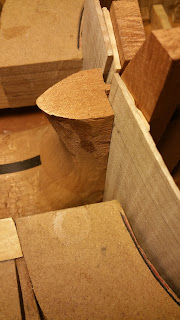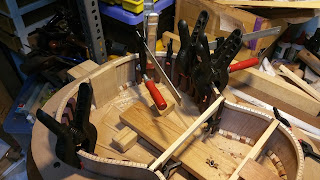20170224
It's really been a quite a while since I last posted.
I have been busy with my day job.
There has been a major reorg in my company and I am tasked a lot more things to do.
So end up I didn't have much time for building guitars.
Nonetheless I managed to do a couple of repairs and some guitar building.
Here I prepared for the assembly by cutting the rebate on the guitar heel block.
The easiest way is probably to use a router, but for me I use hand tools mainly and for this job I use the router plane and block plane.
I measure the thickness of the top at that point and cut the rebate.
Usually I cut a little deeper, and patch up the upper bout with a piece of horizontal grain spruce to protect it against cracks cause by the fingerboard.
This portion is very prone to cracks due to the expansion of the ebony fingerboard.
With dual protection from the extended heel block and spruce patch, this part is secured.
Of course it has the additional advantage of lending weight to the top notes
20170721
After preparing the patch, I finally glue the patch to the the top.
20170728
I aligned the top to the neck.
Then I drill some pilot hole thru' the top and the neck.
Then I shave some 3mm dowels for alignment.
Finally I glued the top to the neck, ensuring the centre line is aligned.
After the glue dried substantially, I release the clamp and put the entire assembly into the solera.
This is the start of the assembly.
I has to aligned the top and neck carefully in the solera to ensure the fitting is good.
Next I glued in the end block.
The end block has be pre-shaped to fit the end part of the guitar previously.
20170804
Next I started to glue in the peones or the lining block.
I was thinking to use ABW for the lining blocks but thought against it.
I was pondering to make this guitar a ultralight guitar of one with a heavy sides.
Meanwhile I can use my normal peones first and decide later.
20170816
I shape the wedges for fitting neck with the sides in place.
As the wedge is not thick enough, I added a piece of maple to the sides in the same grain direction as the sides.
After that I glued in the wedges.
Next I began to shape the rim of the sides.
I use my radius stick as reference and use the block plane (normal block since my LA block is out of action...) to shape the rim accordingly.
Finally I began to glue the back lining.
I leave a little protruding to allow for the sanding / planing of the lining to the radius.

Doing the side support struts for the LTB and UTB.
The support struts is a bit complicated due to the slanted angles by the curving sides in the LTB.
20171101
I finally finished shaping the 2 back brace after taking some time to decide how to go about doing it.
I did a joint on the 1st back brace and foot.
The foot will extend 1/2 into the width of the brace thus supporting one another.
The problem arose because the foot wasn't thick enough to accommodate the brace entirely and I don't wish to shave off too much of the back brace.
Thus by doing this way I can retain the strength and still support one another.
20171114
Next I began to work on the side braces.
I have to notch the lining in order to fit the side braces.
This is to prevent stress risers on the sides if they are butted against the lining.
After which I began to glue the side braces, starting with the side braces supporting the traverse braces.
20171214
Finally I managed to glued all the side braces for the lower bout.
I weigh the braces it ends up about 450g.
Think I wont be adding more braces.
20171222
I patched up the lining to close the gaps between the back braces and the back lining.
After which I began to glue the decoration piece for the LTB and UTB side supports.
It's has the same grain direction as the sides and hence it doesn't offer any much support; it's really for decoration.
Also I glue in the 1st back brace to the heel and rims.
Before that I weigh the back brace to see it's weight.

































No comments:
Post a Comment